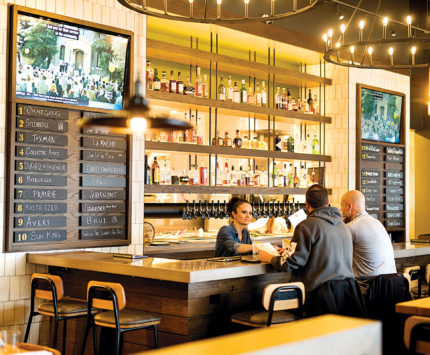The Jury’s Out On The City-County Building’s Fate

The current City-County Building replaced the original Marion County Courthouse in 1962.Photo courtesy W.H. Bass Photo Company Collection, Indiana Historical Society
Years before Unigov was a gleam in Mayor Richard Lugar’s eye, the City-County Building (CCB) was designed to consolidate city and county functions. It brought Indy’s city government, the nine Marion County townships, the Indianapolis Police Department, and the Marion County Courts together under one roof. Before this, city and county offices were distributed around Old City Hall, the Marion County Courthouse, and various rented spaces. The CCB opened in January 1962, almost a full decade before Unigov was established.
It was the first Indianapolis building that was taller than the Soldiers and Sailors Monument. The 28-story CCB held the title of the city’s tallest until 1970, when Regions Tower was completed.
Many think the building isn’t exactly pretty. Essentially a large rectangle flanked by two smaller boxes, the CCB was described by one contemporary architecture critic as “almost a negative achievement.”
But the city recently dropped several million dollars to revamp the building’s plaza. For most of its life, the portion of the CCB complex facing Washington Street was fronted by a barren concrete pad. This area underwent a renovation in 2018, which equipped it with everything from a splash park to giant banks of porch swings. It’s now called Lugar Plaza.
The CCB’s neighborhood is a development hotbed. The land around it already hosts such high-class newcomers as Cummins’s distribution headquarters, the 360 Market Square apartment tower, and the Julia M. Carson Transit Center.
How, or whether, the CCB will participate in that bright future is anyone’s guess. The opening of the new Community Justice Campus on the southeast side will leave the CCB roughly half empty, with some believing that the remaining city functions (including the mayor’s office) should be relocated to Old City Hall and the CCB either razed or converted to private use. A couple of preliminary studies say it will cost more than $40 million to bring its HVAC and electrical systems up to code, plus make the interior suitable for private use, be it residential, retail, offices, or a mix of all three. It also doesn’t help that the place is absolutely shot through with asbestos.
Some see a case for bulldozing it. “The City-County Building ought to be demolished, allowing the entire block on which it sits to be redeveloped from scratch,” says urban analyst Aaron Renn. “The plaza is on the site of the gorgeous and genuinely historic Marion County Courthouse that was demolished to make way for it. So it would be appropriate that the CCB itself get the architectural death penalty.”
Some see a case for keeping it. The building is one of the city’s few examples of midcentury-modern architecture, best represented by the steel- and glass-clad skyscrapers that make up a large part of the skylines of most of the world’s cities. “I think you could save a big part of it and redevelop that site with additional construction and still have something significant,” says James Kienle, architect and director of the Historic Preservation Design Studio at Moody Nolan.
It may be a good, long time before a final decision is made. A request for ideas on what to do with the site was issued this past fall by the city’s Office of Finance & Management, garnering interest from about 40 firms that turned in their suggestions for the place in late October. The various proposals should be seen not necessarily as definitive offers, but as a starting point for determining a way forward. The OFM plans to review the responses and chart its next steps in early 2022. “It’s important to remember that nothing has been determined at this time,” says Sonya Seeder, real estate administrator for the city of Indianapolis. “This request for ideas will just help provide the city with baseline information to make an informed decision.”





